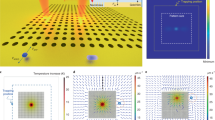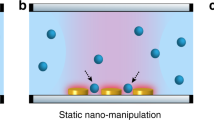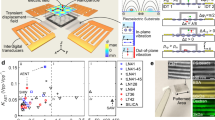Abstract
Optical manipulation of plasmonic nanoparticles provides opportunities for fundamental and technical innovation in nanophotonics. Optical heating arising from the photon-to-phonon conversion is considered as an intrinsic loss in metal nanoparticles, which limits their applications. We show here that this drawback can be turned into an advantage, by developing an extremely low-power optical tweezing technique, termed opto-thermoelectric nanotweezers. By optically heating a thermoplasmonic substrate, a light-directed thermoelectric field can be generated due to spatial separation of dissolved ions within the heating laser spot, which allows us to manipulate metal nanoparticles of a wide range of materials, sizes and shapes with single-particle resolution. In combination with dark-field optical imaging, nanoparticles can be selectively trapped and their spectroscopic response can be resolved in situ. With its simple optics, versatile low-power operation, applicability to diverse nanoparticles and tunable working wavelength, opto-thermoelectric nanotweezers will become a powerful tool in colloid science and nanotechnology.
This is a preview of subscription content, access via your institution
Access options
Access Nature and 54 other Nature Portfolio journals
Get Nature+, our best-value online-access subscription
$29.99 / 30 days
cancel any time
Subscribe to this journal
Receive 12 print issues and online access
$209.00 per year
only $17.42 per issue
Buy this article
- Purchase on Springer Link
- Instant access to full article PDF
Prices may be subject to local taxes which are calculated during checkout




Similar content being viewed by others
References
Lehmuskero, A. et al. Laser trapping of colloidal metal nanoparticles. ACS Nano 9, 3453–3469 (2015).
Li, Z., Mao, W., Devadas, M. S. & Hartland, G. V. Absorption spectroscopy of single optically trapped gold nanorods. Nano. Lett. 15, 7731–7735 (2015).
Selhuber-Unkel, C. et al. Quantitative optical trapping of single gold nanorods. Nano. Lett. 8, 2998–3003 (2008).
Bosanac, L., Aabo, T., Bendix, P. M. & Oddershede, L. B. Efficient optical trapping and visualization of silver nanoparticles. Nano. Lett. 8, 1486–1491 (2008).
Pelton, M. et al. Optical trapping and alignment of single gold nanorods by using plasmon resonances. Opt. Lett. 31, 2075–2077 (2006).
Hansen, P. M., Bhatia, V. K., Harrit, N. & Oddershede, L. Expanding the optical trapping range of gold nanoparticles. Nano. Lett. 5, 1937–1942 (2005).
Yan, Z., Sajjan, M. & Scherer, N. F. Fabrication of a material assembly of silver nanoparticles using the phase gradients of optical tweezers. Phys. Rev. Lett. 114, 143901 (2015).
Bendix, P. M., Jauffred, L., Norregaard, K. & Oddershede, L. B. Optical trapping of nanoparticles and quantum dots. IEEE J. Sel. Top. Quantum Electron. 20, 15–26 (2014).
Ruijgrok, P. V. et al. Brownian fluctuations and heating of an optically aligned gold nanorod. Phys. Rev. Lett. 107, 037401 (2011).
Shao, L. et al. Gold nanorod rotary motors driven by resonant light scattering. ACS Nano 9, 12542–12551 (2015).
Min, C. et al. Focused plasmonic trapping of metallic particles. Nat. Commun. 4, 2891 (2013).
Babynina, A. et al. Bending gold nanorods with light. Nano. Lett. 16, 6485–6490 (2016).
Govorov, A. O. & Richardson, H. H. Generating heat with metal nanoparticles. Nano Today 2, 30–38 (2007).
Baffou, G. & Quidant, R. Thermo-plasmonics: using metallic nanostructures as nano-sources of heat. Laser Photon. Rev. 7, 171–187 (2013).
Ndukaife, J. C. et al. Long-range and rapid transport of individual nano-objects by a hybrid electrothermoplasmonic nanotweezer. Nat. Nanotech. 11, 53–59 (2016).
Braun, M. & Cichos, F. Optically controlled thermophoretic trapping of single nano-objects. ACS Nano 7, 11200–11208 (2013).
Braun, M. et al. Single molecules trapped by dynamic inhomogeneous temperature fields. Nano. Lett. 15, 5499–5505 (2015).
Flores-Flores, E. et al. Trapping and manipulation of microparticles using laser-induced convection currents and photophoresis. Biomed. Opt. Express 6, 4079–4087 (2015).
Chen, J. et al. Thermal gradient induced tweezers for the manipulation of particles and cells. Sci. Rep. 6, 35814 (2016).
Lin, L. et al. Light-directed reversible assembly of plasmonic nanoparticles using plasmon-enhanced thermophoresis. ACS Nano 10, 9659–9668 (2016).
Nikoobakht, B. & El-Sayed, M. A. Evidence for bilayer assembly of cationic surfactants on the surface of gold nanorods. Langmuir 17, 6368–6374 (2001).
Smith, D. K. & Korgel, B. A. The importance of the CTAB surfactant on the colloidal seed-mediated synthesis of gold nanorods. Langmuir 24, 644–649 (2008).
Tadros, T. F. Applied Surfactants: Principles and Applications Ch. 3 (Wiley-VCH, Weinheim, Germany, 2005).
Reichl, M., Herzog, M., Götz, A. & Braun, D. Why charged molecules move across a temperature gradient: the role of electric fields. Phys. Rev. Lett. 112, 198101 (2014).
Majee, A. & Würger, A. Charging of heated colloidal particles using the electrolyte Seebeck effect. Phys. Rev. Lett. 108, 118301 (2012).
Zheng, Y. et al. Nano-optical conveyor belt, part II: demonstration of handoff between near-field optical traps. Nano. Lett. 14, 2971–2976 (2014).
Grigorenko, A. N., Roberts, N. W., Dickinson, M. R. & Zhang, Y. Nanometric optical tweezers based on nanostructured substrates. Nat. Photon. 2, 365–370 (2008).
Amos, D. A., Markels, J. H., Lynn, S. & Radke, C. J. Osmotic pressure and interparticle interactions in ionic micellar surfactant solutions. J. Phys. Chem. B 102, 2739–2753 (1998).
Vigolo, D., Buzzaccaro, S. & Piazza, R. Thermophoresis and thermoelectricity in surfactant solutions. Langmuir 26, 7792–7801 (2010).
Würger, A. Hydrodynamic boundary effects on thermophoresis of confined colloids. Phys. Rev. Lett. 116, 138302 (2016).
Prikulis, J. et al. Optical spectroscopy of single trapped metal nanoparticles in solution. Nano. Lett. 4, 115–118 (2004).
Demergis, V. & Florin, E.-L. Ultrastrong optical binding of metallic nanoparticles. Nano. Lett. 12, 5756–5760 (2012).
Iracki, T. D., Beltran-Villegas, D. J., Eichmann, S. L. & Bevan, M. A. Charged micelle depletion attraction and interfacial colloidal phase behavior. Langmuir 26, 18710–18717 (2010).
Ohlinger, A., Nedev, S., Lutich, A. A. & Feldmann, J. Optothermal escape of plasmonically coupled silver nanoparticles from a three-dimensional optical trap. Nano. Lett. 11, 1770–1774 (2011).
Tong, L., Miljković, V. D., Johansson, P. & Käll, M. Plasmon hybridization reveals the interaction between individual colloidal gold nanoparticles confined in an optical potential well. Nano. Lett. 11, 4505–4508 (2011).
Blattmann, M. & Rohrbach, A. Plasmonic coupling dynamics of silver nanoparticles in an optical trap. Nano. Lett. 15, 7816–7821 (2015).
Scarabelli, L. et al. Monodisperse gold nanotriangles: size control, large-scale self-assembly, and performance in surface-enhanced Raman scattering. ACS Nano 8, 5833–5842 (2014).
Coskun, S., Aksoy, B. & Unalan, H. E. Polyol synthesis of silver nanowires: an extensive parametric study. Cryst. Growth Des. 11, 4963–4969 (2011).
Bartsch, T. F. et al. Nanoscopic imaging of thick heterogeneous soft-matter structures in aqueous solution. Nat. Commun. 7, 12729 (2016).
Pralle, A., Florin, E. L., Stelzer, E. H. K. & Hörber, J. K. H. Local viscosity probed by photonic force microscopy. Appl. Phys. A 66, S71–S73 (1998).
Acknowledgements
Y.Z. acknowledges the financial supports of the Beckman Young Investigator Program, the Army Research Office (W911NF-17-1-0561), the National Aeronautics and Space Administration Early Career Faculty Award (80NSSC17K0520) and the National Institute of General Medical Sciences of the National Institutes of Health (DP2GM128446). E.-L.F. acknowledges the financial support of the National Science Foundation (DMR-1310559 and DMR-1710646). B.A.K. and E.A. acknowledge the financial supports of the Robert A. Welch Foundation (F-1464) and the National Science Foundation (EFMA-1346647). We also thank the Texas Advanced Computing Centre at The University of Texas at Austin (http://www.tacc.utexas.edu) for providing HPC resources that have contributed to the research results reported within this paper.
Author information
Authors and Affiliations
Contributions
L.L. and Y.Z. conceived the idea. L.L., M.W. and X.P. prepared the materials, worked on the trapping experiments and collected the data. E.N.L., X.P. and E.-L.F. worked on the measurements of trapping stiffness. Z.M. conducted the computational fluid dynamic simulations. L.L. conducted finite-difference time-domain simulations. L.S. and L.M.L.-M. synthesized the AuNTs. E.A., S.C., H.E.U. and B.A.K. synthesized the AgNWs. Y.Z. supervised the project. All authors participated in the discussion of the results and wrote the manuscript.
Corresponding author
Ethics declarations
Competing interests
The authors declare no competing interests.
Additional information
Publisher’s note: Springer Nature remains neutral with regard to jurisdictional claims in published maps and institutional affiliations.
Supplementary information
Supplementary Information
Supplementary Figures and Supplementary Notes.
Supplementary Video 1
Real-time trapping, dynamic transport and release of a single 100-nm Ag nanosphere (AgNS).
Supplementary Video 2
Parallel trapping of six 100-nm AgNSs in a circle.
Supplementary Video 3
Trapping and rotation of a single Ag nanowire (AgNW).
Rights and permissions
About this article
Cite this article
Lin, L., Wang, M., Peng, X. et al. Opto-thermoelectric nanotweezers. Nature Photon 12, 195–201 (2018). https://doi.org/10.1038/s41566-018-0134-3
Received:
Accepted:
Published:
Issue Date:
DOI: https://doi.org/10.1038/s41566-018-0134-3
This article is cited by
-
Towards a comprehensive characterization of spatio-temporal dependence of light-induced electromagnetic forces in dielectric liquids
Scientific Reports (2024)
-
Determining intrinsic potentials and validating optical binding forces between colloidal particles using optical tweezers
Nature Communications (2024)
-
Advancing optothermal manipulation: decoupling temperature and flow fields in quasi-isothermal microscale streaming
Light: Science & Applications (2023)
-
Hypothermal opto-thermophoretic tweezers
Nature Communications (2023)
-
Optofluidic transport and assembly of nanoparticles using an all-dielectric quasi-BIC metasurface
Light: Science & Applications (2023)



